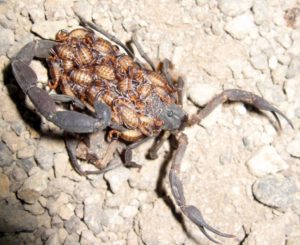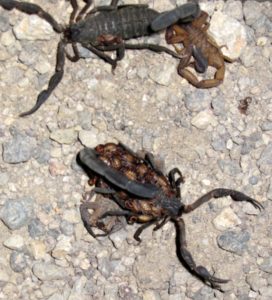by Todos Santos Eco Adventures
What do scorpions have in common with humans? Unlike most of their fellow arachnids and invertebrates but very much like humans, scorpions are viviparous, i.e., they give birth to live young one by one. The scorpion babies look like miniature adults, except that they are very light in color (adults are dark) and cannot sting. This lack of stinging ability may help promote family harmony as almost immediately after birth baby scorpions climb onto their mother’s back, a perch they enjoy for several days until their first molt (longer for some species). The mother scorpion does not feed her babies, but she does carry and protect them until they are able to hunt for themselves. Unless, of course, she gets too hungry in which case she no longer recognizes the small arachnids are her babies and eats them! Some time after the first molt young scorpions leave the (relative) safety of their mother’s back to establish their own territories.

Mama Scorpion with Babies on Her Back
The body of a scorpion is divided into two parts: the cephalothorax (also called the prosoma) and the abdomen (opisthosoma). The cephalothorax is the scorpion’s “head”, comprising the carapace, eyes, chelicerae (mouth parts), pedipalps (claws) and four pairs of walking legs. The scorpion’s exoskeleton is thick and durable, providing good protection from predators. Scorpions have two eyes on the top of the head, and usually two to five pairs of eyes along the front corners of the head. In the summers in Baja scorpions can be seen raising their bodies off the ground to cool their undersides.

Scorpion Family Photo
Scorpions play an important role in the ecosystem of Baja by helping to keep the insect population under control. They also like to eat spiders, small mice and lizards. But they don’t eat every day; in fact scorpions have been known to go without food for up to 12 months if they have sufficient water. Typically though scorpions will have a meal at least once every 2 to 3 weeks. They are quite resourceful in going after these meals. Some stalk their prey and some will even dig a trap in the sand for their prey to fall into.
Others take a more relaxed approach and just wait by their burrow with their pincers open and stingers raised until unsuspecting prey wanders by. Once prey is within reach the scorpion grabs it and crushes it with their pincers. Scorpions try not to use their venomous sting unless absolutely necessary as it takes a great deal of body energy to produce more venom. Younger and smaller scorpions tend to use their stingers more often than larger and older ones. Scorpions have very small mouths and can only take in liquid, so captured prey is crushed and injected with enzymes that dissolve the insides. Scorpions are remarkable survivors. If necessary, they can slow their metabolism to as little as one-third the typical rate for arthropods. In this way the scorpion greatly reduces its intake of oxygen and can live on as little as a single insect per year. But unlike most hibernating species, even with lowered metabolism the scorpion has the ability to spring quickly to the hunt when the opportunity presents itself.
© Copyright Sergio and Bryan Jauregui, Casa Payaso S de RL de CV, 2012
